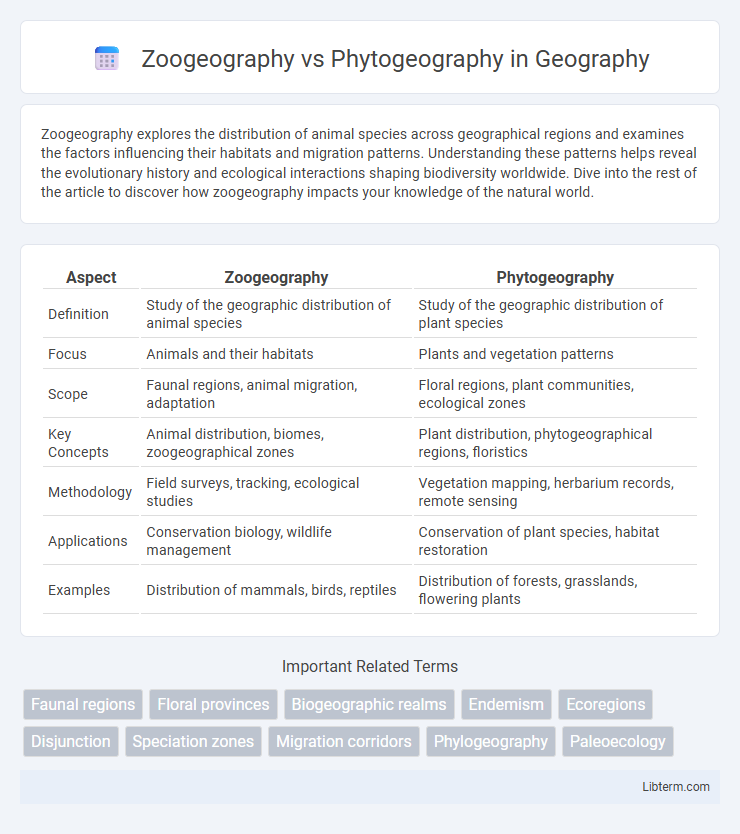Zoogeography explores the distribution of animal species across geographical regions and examines the factors influencing their habitats and migration patterns. Understanding these patterns helps reveal the evolutionary history and ecological interactions shaping biodiversity worldwide. Dive into the rest of the article to discover how zoogeography impacts your knowledge of the natural world.
Table of Comparison
| Aspect | Zoogeography | Phytogeography |
|---|---|---|
| Definition | Study of the geographic distribution of animal species | Study of the geographic distribution of plant species |
| Focus | Animals and their habitats | Plants and vegetation patterns |
| Scope | Faunal regions, animal migration, adaptation | Floral regions, plant communities, ecological zones |
| Key Concepts | Animal distribution, biomes, zoogeographical zones | Plant distribution, phytogeographical regions, floristics |
| Methodology | Field surveys, tracking, ecological studies | Vegetation mapping, herbarium records, remote sensing |
| Applications | Conservation biology, wildlife management | Conservation of plant species, habitat restoration |
| Examples | Distribution of mammals, birds, reptiles | Distribution of forests, grasslands, flowering plants |
Introduction to Zoogeography and Phytogeography
Zoogeography studies the geographic distribution of animal species and their ecological relationships, analyzing factors like habitat, climate, and evolutionary history that influence animal populations across different regions. Phytogeography examines the spatial distribution of plant species and communities, focusing on environmental conditions, soil types, and climatic factors that determine vegetation patterns. Both disciplines provide crucial insights into biodiversity, ecosystem dynamics, and the impact of geographical barriers on species dispersal.
Defining Zoogeography: Study of Animal Distribution
Zoogeography examines the spatial distribution of animal species across various habitats and regions, analyzing factors such as climate, topography, and evolutionary history that influence animal dispersion. It involves mapping species populations, migration patterns, and biogeographical boundaries to understand biodiversity and ecosystem dynamics. Phytogeography, by contrast, focuses on the distribution of plant species, emphasizing vegetation zones, soil types, and climatic effects on plant communities.
Defining Phytogeography: Study of Plant Distribution
Phytogeography is the scientific study of the geographic distribution of plant species and vegetation types across different regions. It examines patterns influenced by environmental factors such as climate, soil, and altitude, as well as historical events like glaciations and continental drift. This field contrasts with zoogeography, which focuses on the distribution of animal species, highlighting distinct ecological and evolutionary processes shaping biodiversity.
Historical Development of Zoogeography and Phytogeography
The historical development of zoogeography traces back to early naturalists like Alfred Russel Wallace, who systematically studied animal distribution patterns and contributed foundational concepts to biogeography. Phytogeography evolved from botanical explorations by scientists such as Alexander von Humboldt, who analyzed plant distributions and their relationship to environmental factors. Both fields advanced through the integration of evolutionary theory and ecological principles, shaping modern biogeographical studies.
Major Factors Influencing Animal Distribution
Animal distribution in zoogeography is predominantly influenced by factors such as climate, availability of food resources, and physical barriers like mountains and rivers that limit species migration. In contrast to phytogeography, where soil type and sunlight play critical roles, zoogeography emphasizes habitat suitability and interspecific interactions like predation and competition. Evolutionary history and continental drift also shape animal distribution patterns by affecting species dispersal and isolation over geological time scales.
Key Factors Affecting Plant Distribution
Climate, soil composition, altitude, and human activity are principal determinants influencing plant distribution in phytogeography, shaping patterns of vegetation across different regions. Unlike zoogeography, which emphasizes animal dispersal and migration barriers, phytogeography considers seed dispersal mechanisms, photosynthesis requirements, and water availability as critical factors. Geological history, such as glaciations and plate tectonics, also plays a significant role in the current distribution of plant species globally.
Methodologies in Zoogeographical Research
Zoogeographical research employs methodologies such as species distribution modeling, biogeographical surveys, and phylogenetic analysis to understand animal population patterns and historical dispersal processes. Techniques include GPS tracking, ecological niche modeling, and comparative anatomy studies to map fauna diversity across regions. Data integration from molecular genetics and fossil records enhances the accuracy of zoogeographical mapping and evolutionary interpretations.
Techniques Used in Phytogeographical Studies
Phytogeographical studies primarily use field surveys, remote sensing, and Geographic Information Systems (GIS) to analyze plant distribution patterns and environmental relationships. Techniques such as herbarium specimen analysis, vegetation mapping, and ecological niche modeling help identify floristic regions and understand plant migration. These methods provide comprehensive data on plant species diversity, habitat conditions, and biogeographical boundaries, differentiating phytogeography from zoogeography's focus on animal distribution techniques.
Comparative Analysis: Zoogeography vs Phytogeography
Zoogeography examines the distribution of animal species across geographical regions, focusing on factors such as habitat, climate, and evolutionary history, while phytogeography studies the spatial distribution of plant species and vegetation patterns influenced by soil, climate, and ecological interactions. Both disciplines utilize biogeographical principles but differ in their primary subjects, with zoogeography emphasizing fauna migration and adaptation, and phytogeography concentrating on plant community dynamics and environmental gradients. Comparative analysis reveals that zoogeography often highlights animal mobility and behavioral traits, whereas phytogeography centers on plant dispersal mechanisms and abiotic influences like soil composition and microclimates.
Applications and Future Trends in Biogeographical Sciences
Zoogeography and phytogeography both play crucial roles in understanding species distribution patterns, with zoogeography focusing on animal habitats and phytogeography on plant distributions, which aids in biodiversity conservation and habitat restoration efforts. Applications in climate change modeling and ecological niche prediction increasingly rely on integrating data from both fields to improve accuracy in forecasting species shifts and ecosystem resilience. Future trends emphasize leveraging remote sensing technology, genomic data, and AI-driven analytics to enhance precision in biogeographical mapping and support adaptive management strategies in response to environmental change.
Zoogeography Infographic

 libterm.com
libterm.com